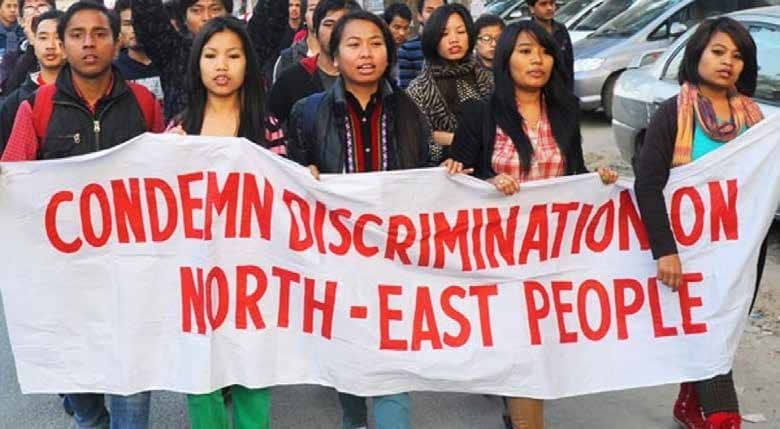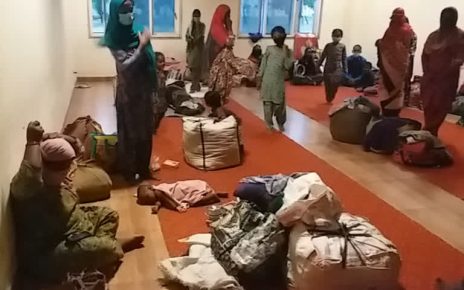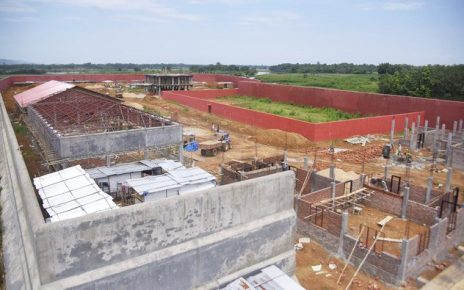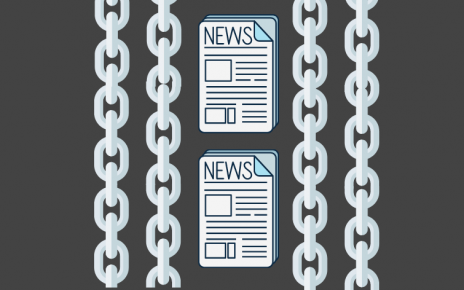Northeast Today
12 June 2020
Before the first case of the novel corona virus was detected in Northeast India, the people of this region, particularly students, young working men-women staying in Indian metros felt the brunt of the pandemic much early. Surprisingly, it was not this deadly virus, which caused trouble to them, but it was something else, though connected with corona, which brought trouble and trauma to their lives. It is a social disease called racism, which was always there in India since a long time it found its new host among ignorant citizens of the country during the time of corona against the people of Northeast India. Northeast Today writes
On 22nd March, on the day of Janata curfew called by PM Narendra Modi to curb the coronavirus pandemic, when a 25 years old Northeastern woman stepped out of her house in North Delhi’s Vijaynagar to get some groceries along with her two friends faced racist attack and had to experience a horrible incident. A man, on white scooty probably chewing paan spat on her when she was on her way to the market and called her ‘Corona’ before fleeing the spot.
As per media reports, the victim while recalling the traumatic incident said, “He whizzed past me, and spat the paan on my face and shouted “corona”, and left. It was quite a deliberate attack and I was too shocked to react.” An M Phil student of the Department of English, from Delhi University, had been living in Delhi for over seven years and had never experienced anything like this before, though racial attack on people of Northeast in Delhi is not rare. Delhi police had registered a case and arrested the accused in this matter.
Unfortunately, racial attacks related to corona on Northeast Indians didn’t stop with this single incident. A series of such attack were reported in various parts of the country where people of Northeast India were called, ‘coronavirus’ and were harassed, abused and traumatized. Though the attack on Northeastern due to their looks is not new in Indian cities, such hate crimes multiplied within a short span of time amid the corona pandemic. The Northeast Support Centre and Helpline, which was established in 2007 to assist people from northeastern Indian states, has been inundated with distress calls from across the country during the lockdown period. “I get five to six phone calls about racial abuse almost every day,” Alana Golmei, who manages the helpline, told to media.
It is worth mentioning here that a few days later, after the Delhi incident of March 22, a similar incident took place in Mumbai, where a girl from Northeast faced racial discrimination and was traumatized. She too was spat on allegedly by a biker in Kalina Market area in Mumbai. The National Commission for Women had taken suo motu cognisance of the incident.
A report released on March 26, by Right and Risks Analysis Group (RRAG) actually confirms what the Northeast Support Centre and Helpline had experienced. It states that in the aftermath of COVID-19 outbreak, there has been a massive and unprecedented upsurge of acts of racism and racial discrimination against people from the North East who are settled, working and studying across the length and breadth of the country. The report cites 22 reported cases of racial discrimination or hate crimes since February 7, 2020, to March 25, 2020. Suhas Chakma, director or RRAG told to media that those incidents were just the tip of the iceberg as India’s Mongoloid looking people had been facing discrimination on a daily basis and the same does not make news. Chakma stated, “India has imposed countrywide lock-down from 25.03.2020 to contain the deadly virus, which has been increasingly creating “Sinophobia” with dire consequences for people who look similar to the Chinese. As the fear and prejudices associated with COVID-19 spreads across the country, India’s Mongoloid looking people are all set to face increased acts of racism and racial discrimination with virtual impunity as there is neither a law nor public rebuke from the key leaders of the government of India against these despicable crimes”.

What Chakma called “Sinophobia” is so strong among some people that nine Naga youths, just because of their physical features, were forced to undergo 24-hours quarantine in Ahmedabad, Gujarat, on March 20 despite showing no symptoms. Though these youths working in an insurance company’s call centre had no physical symptoms of the disease, no foreign travel history or no apparent contact with any laboratory-confirmed COVID-19 patient, still they had to spend the night in a government quarantine facility meant for suspected coronavirus infected persons allegedly because of their Mongoloid looks.
Why this discrimination?
It is interesting to note that these acts of racism and racial discrimination have taken place in upscale restaurants and campuses of prestigious institutions like the Kirori Mal College of Delhi University, the Tata Institute of Social Sciences (TISS), Mumbai, and the National Co Council of Educational Research and Training (NCERT). The incidents had taken place across the country in places such as Gujarat, Delhi, Tamil Nadu, Punjab, West Bengal and Maharashtra, showing that prejudice, acts of racism and racial discrimination are not confined to a particular state or area as per the report of RRAG. This nature of incident implies that alienating people of Northeast India by the mainstream has been generalized and has become an acceptable idea even among the so called educated people.
Discrimination due to physical features against the people of northeast India is not new and it has been going on for a while, almost for many decades. Not knowing Northeast India as an integral part of India and its people as Indian citizen have become an acceptable discourse and was sometimes neglected considering as a matter of ignorance. In some cases, such instances are taken in light note and many from Northeast India enjoy the pleasure of being treated as foreigners in their own country. However, in many cases it turned ugly as this ignorance resulted in physical attack, humiliation leading to trauma which goes beyond calling someone “momo” or “chinky”.
The prime reason for this racial discrimination to people of Northeast India is the facial feature which resembles South and Southeast countries like Thailand, Myanmar, China etc and which are foreign country for common Indians. The “Northeast India” perfectly fits Indian’s imagination of Chinese. As per the present context, though corona has its origin in China the people of Northeast India are continuously being attacked or abused due to similarity in their features and looks to that of Han Chinese. Victims of the attack say, their Chinese looks has caused them to be physically attacked and abused on social media. “My colleague was recently attacked and verbally abused outside Delhi. We have always faced racism in the past, but this time it was taken to a new level,” Thokchom Singhajit, general secretary of Manipur Students Association, told to media.
It is important to remember here the tragic case of Nido Tania who was killed in an incident was later perceived as a racial attack. On January 29, 2014, Nido Tania, a 20-year-old college student from Arunachal Pradesh, died of severe lung and brain injuries from an attack inflicted upon him in a South Delhi market. Murder of Nido had led to a national debate on discrimination against Indians from the North East in 2014 which led to the intervention of the Ministry of Home Affairs into the matter.
Understanding and considering the seriousness of the Nido Tania incident and past such cases of racial discrimination against the people of Northeast India, the Ministry of Home Affairs set up a committee under the Chairmanship of Shri M.P. Bezbaruah, IAS (Retd) the same year. The committee was formed to look into various kinds of concerns of the people hailing from North Eastern states of India who are living in different parts of the country, especially the Metropolitan cities and to suggest suitable remedial measure which could be taken up by the Government.
The 82-page report which was submitted in mid of 2014 paints a grim picture of the nature and extent of discrimination and attacks against the Northeast community. It provides a comprehensive list of short-term and long-term measures that must be taken by the government to counter discrimination against the community.
According to the report over two lakh people from the Northeast have migrated to Delhi between 2005 and 2013 and that about 86 percent of them have faced discrimination. It also finds that Delhi is the worst offender among the metro cities on ground of racial discrimination against people from the Northeast. The committee suggested five key recommendations on tackling discrimination against people of Northeast India. They are: 1) New law against discrimination, 2)Fast-track courts and special police squads, 3)Interventions in Education, 4) Social media outreach and legal awareness campaigns and 5) Bonding power of sports. However, it is not clear, up to what extent these recommendations have been respected and implemented.
Though the current racial discrimination against people of Northeast India, has its roots in the past, it has now become a part of the global Sinophobia phenomena. President Donald Trump has recently insisted on repeatedly calling the Covid-19 either a “foreign virus” or a “Chinese virus” in his speeches and tweets, an insistence that appears to say “this is all China’s fault.” In places where Asians are a visible minority such as Europe, the US and Australia, the Sinophobia is a reality. Discrimination against China and Chinese people is not new – Sinophobia is a well-documented phenomenon that has existed for centuries.

Winning the real fight:
According to a news report the Northeastern states, with 8% of India’s landsize and 3.6% of the total population of the country, not only has a mere 35 confirmed cases of the coronavirus, but the rate of local transmission is extremely low, prompting health authorities in the region to believe that perhaps its people are more immune. The report also stated that about 2,000 people who came in contact with 31 corona patients were tested for COVID- 19, the virus that causes SARS CoV 2, and all of them were found negative. Till the end of April, Assam has 28 positive cases linked to the Tablighi Jamaat in Delhi. According to Lakshmanan S, Mission Director of the state’s National Health Mission, 1,200-1,300 people who are believed to have come in contact with the 28 Tablighis were tested but all of them were found negative. Similarly, about 500 people were tested for the virus when they came in contact with an infected American tourist who went on a seven-day cruise on the Brahmaputra river, stayed at a luxury hotel in Guwahati and later at a resort in Jorhat next to the Kazaringa sanctuary. But all of them were tested negative. However, this report seems to be based on assumptions, but states clearly that Northeast is in a better position compared to other parts of India when it comes to corona crisis.
On April 27, Junior Minister for Development of North Eastern Region (DoNER) Jitendra Singh stated that five out of eight states in the north-east have no coronavirus cases. The other three states have not reported any new COVID-19 cases in the last few days, the government said. As time will pass, the scenario may change either better or worse, but this statement from the Government implies that Northeast is fighting the COVID 19 battle well.
Meanwhile, the news of welcoming of the 24-year-old nurse from Manipur by her neighbourhood in Delhi is surely news of hope and changed society. The nurse contracted COVID-19 in the line of duty at a private hospital in Delhi and was discharged from hospital after she tested negative. Whether the fight is against the corona pandemic or against racism, it is not a lonely fight for the people of Northeast India alone. It should not be one. India as a nation has to overcome both the challenges with dignity and hard work. One fine day the human society will overcome the crisis of corona, the way it has overcome other pandemics in the past. But racism may remain for a longer period as it infects the mind and society and not the body. Only a changed heart and reformed society can eliminate social diseases like racism.

Recommendations made by the Bezbaruah Committee on tackling discrimination against the people of Northeast India:
New law against discrimination: Either a new law should be promulgated as directed by the High Court of Delhi or the Indian Penal Code should be amended. The offence should be cognizable and non-bailable. The investigation of the FIR should be completed in 60 days by a special squad and investigated by a police officer, not below the rank of deputy SP or ACP. A special prosecutor should be appointed to handle all such cases of atrocities. And the trial should be completed in 90 days.
Fast-track courts and special police squads: The Committee strongly suggests the creation of fast-track courts for handling the cases relating to the North East people, particularly those which are racially motivated and involving heinous crimes against the North East women and children. Specially designated public prosecutors should be appointed for cases involving people from the North East. They should also be properly trained and sensitised.
The committee feels that the creation of a special squad supervised by the North East Special Police Unit would go a long way in ensuring speedy justice in criminal cases. The squad could be manned by people specially selected for such purposes and they could be specially trained and sensitised about the problems of people from the North East.
Interventions in Education: Suitable innovative ways should be devised to integrate each and every aspect of the North East into the consciousness of people outside. The Committee recommends that when the next the NCERT takes place, one, all teacher training institutes be advised to make their syllabus in a way that can sensitise their trainees on the North East and, two, universities and schools outside the North East make projects on North East a mandatory part of the course curricula.
Large migration of students for Higher Education in Delhi and other metros has been a prominent feature in recent times. One reason for such exodus is the absence of institutions of excellence in the North East. A detailed socio-economic study of the nature of student migration from the North East would be worthwhile as it will provide valuable insight for planning of higher education in the region.
Social media outreach and legal awareness campaigns: The committee recommends legal awareness campaigns in neighbourhoods that have a significant presence of members from the North East community and on introducing lectures on legal rights for university students. It underlines the role of social media in improving connectivity and communication with the community. A dedicated Facebook page should be created and nodal police officers should be in constant touch with members of the community on WhatsApp.
Bonding power of sports: The committee recommends that the Ministry should take steps to hold regular national and international events in the North East as such events will create greater harmony and better understanding. The ministry should, therefore, review the status of present facilities and make an assessment if they are suitable for such events. If not, such facilities should be created in every state of the North East. Indigenous games of the North East should be promoted.



